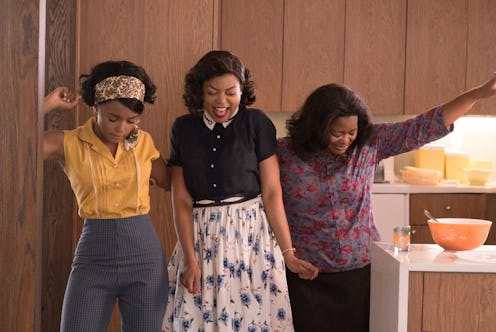
I am an outer space and sci-fi nerd. If it involves space ships, aliens, other planets, space travel, or the true history of humanity's adventures into outer space, I want to read it, watch it, or wear it. As a woman, I seek out equal representation in my space nerd-dom, yet while science fiction has a number of wonderful female characters in novels, television, and film, true story-based film hasn't made the same progress. When it comes to the actual history of space travel, equal representation hasn't seemed like a priority in movies like Apollo 13 or The Right Stuff, despite the fact that history shows that women have been very much involved since the beginning of the space race. This is why I'm so excited about the upcoming film, Hidden Figures , which tells the very true story of some of NASA's most important women. Although the movie doesn't open until Jan. 13, 2017, the trailer, released earlier this month, looks good enough to have me eagerly anticipating the film's impending release.
Hidden Figures is based on the book Hidden Figures: The American Dream and the Untold Story of the Black Women Mathematicians Who Helped Win the Space Race, by Margo Lee Shetterly, and it features an all-star cast. Taraji P. Henson plays Katherine G. Johnson, Octavia Spencer is Dorothy Vaughan, and Janelle Monáe takes on Mary Jackson, three brilliant African-American women who worked at NASA during the famous space race of the 1950s and 60s. The trio were mathematicians, and it was actually Johnson who helped calculate John Glenn’s trajectory around the Earth before he became the first American to orbit the planet. But before hearing about Hidden Figures, I — and likely many others — had never heard of the trip despite their impressive contributions to science, which says a lot about how women in space travel have been treated in pop culture.
Despite being prominent contributors to NASA and space travel history, women have been left out of many of the films that've focused on the topics. If you're into NASA history, you've probably seen Apollo 13, The Right Stuff, October Sky, or the HBO miniseries From the Earth to the Moon, but all of these works are seriously lacking in female representation. ABC aired a miniseries called The Astronaut Wives Club, which I watched in the hope of seeing some active women involved with the space race, but while the characters, the wives of the Mercury 7, were supportive and intelligent, they had little to do with the actual science. I've been waiting to see something, anything, about the women who actually worked at NASA during that time. Sure, there are some great women-in-space movies out there, like Gravity or the Alien franchise, but those stories are fictional, when I long to hear more about the real women involved in the missions.
And I'm clearly not the only one. According to The AP , Hidden Figures star Monáe told a panel at the Essence Festival that she had an emotional reaction to hearing about the three women's journeys. "I cried because I had never heard of Katherine Johnson or Dorothy Vaughan or Mary Jackson. But I know these women and their struggles,” she said. "It is so important, that we as women, African-American women, tell our stories. These three women opened doors for us and literally helped change the world." Monáe's comment brings up an additional element of inclusivity in that Hidden Figures tells the story of women of color who worked at NASA during a time when the civil rights movement was gearing up. The movie does double duty when it comes to representation, and that's something worth celebrating.
And Hidden Figures brings up the point that these women aren't the only ones from that era who were important to space travel history. Did you know that the Soviet Union sent a woman into space 20 years before the USA? Soviet cosmonaut Valentina Tereshkova was the first woman to travel into space in June 1963. She completed 48 orbits at 71 hours, according to Space.com, which means, since NASA reports that, at the time, their astronauts had only completed a total of 36 orbits, Tereshkova spent more time in space than all of the American male astronauts at the time combined. Then, there's the story of Sally Ride, the first American woman to enter space, back in 1983. And there's also Mae Jemison, the first black woman in space. While serving on the Space Shuttle Endeavor, The Huffington Post reports, she'd sign on duty by saying "Hailing frequencies open," the signature line of Star Trek's Lieutenant Uhura. She was even on an episode of Star Trek: The Next Generation. How cool is that?
I'd love to see any of these women's stories made into a film or miniseries. With any luck, Hidden Figures will help make them happen. The men of space travel history have gotten plenty of movies devoted to them, so hopefully Hidden Figures will start the trend of the women of space getting their own representation on-screen.
Images: Fox 2000